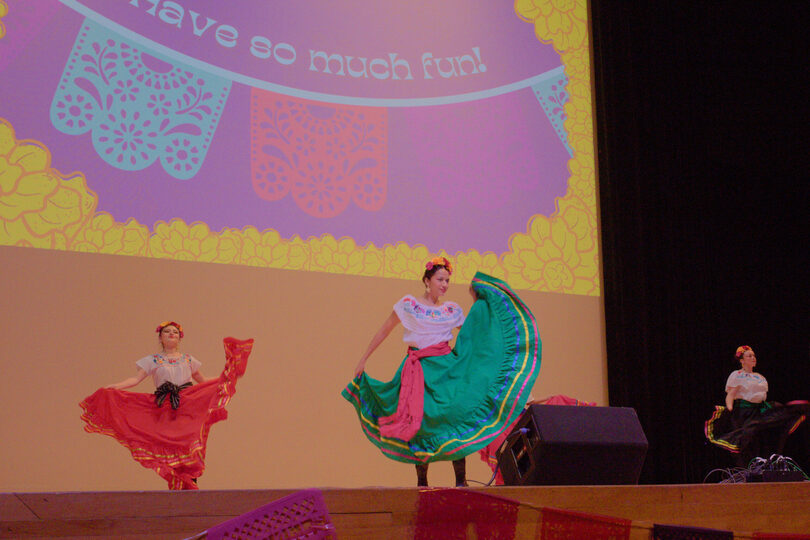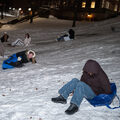Día de los Muertos honors family, cross-cultural roots in joyous celebration

After a dance group that usually performs at Mexican Student Association events cancelled last minute, the organization’s e-board decided to learn a Ballet Folklórico to perform at the Día de los Muertos event. Learning the dance was a bonding experience, the president said. Sean Sterling | Staff Photographer
Get the latest Syracuse news delivered right to your inbox.
Subscribe to our newsletter here.
Mariachi music flowed through Goldstein Auditorium as people shuffled from table to table. Some people wore skeleton face paint, others had candy from breaking open a piñata.
“Seeing that the Goldstein Auditorium is completely decked out for this event just makes me really happy because I’m learning there is so much culture here,” said Florencia Tapia Cortes, a Syracuse University sophomore in La Familia de la Salsa.
The Mexican Student Association held a celebration for Día de los Muertos in Goldstein on Wednesday night. The student organization collaborated with Lambda Theta Alpha Latin Sorority, Inc. and La Latiné Undergraduates Creating History in America.
Día de los Muertos is a holiday indigenous to Mexico. Valeria Martinez-Gutierrez, president of MEXSA said it’s a way to celebrate life after death by making altars de muertos, or altars for the dead, and leaving ofrendas, or offerings, for deceased family members.
“Sometimes people even put cigarettes, if people were chain smokers,” Martinez-Gutierrez said. “It’s a very celebratory holiday, and it’s not meant for it to be full of sorrow or any kind of way.”
Martinez-Gutierrez said she honored her two grandpas this year, both of whom are inspirations to her. She also honored the 35 victims of the Pan Am Flight 103 with altars de muertos.

People who celebrate Día de los Muertos often create ofrendas to honor dead relatives. They leave some of their relatives’ favorite things along with candles and other decorations. Sean Sterling | Staff Photographer
As part of the opening presentation, the executive board of MEXSA performed a Ballet Folklórico, a traditional Mexican dance.
“None of us had danced it before, but because of a last-minute cancellation for the dance troupe we usually hire, we were like, ‘Hey, let’s all learn,’” Martinez-Gutierrez said. “It’s been so fun for bonding and to create community.”
Franco Vivanco, an SU freshman in SALSA, said this event was a collaboration between many multicultural clubs on campus. Tapia Cortes said last year during Día de los Muertos, she didn’t see Latino representation.
Vivanco and Tapia Cortes said that though neither of them celebrates the Día de los Muertos, they have many friends who do.
“We like seeing our Mexican brothers and sisters celebrate, and if we can help them out in any way possible, then that’s great,” Vivanco said. “We’re one big family, so it’s nice to be able to support each other in an environment like this.”
Although Día de los Muertos is a Mexican holiday, tables from South American and Latine Student Association, Haitian American Student Association, Central American Student Association and Lambda Theta Alpha all brought different activities to represent their culture’s version of Día de los Muertos.
Amaya Saintal, president of HASA, said Fèt Gede is celebrated around the same time of year in Haiti, a similar holiday where people honor and recognize those who passed away.
“Typically, this is when they will celebrate with drumming, songs, different colors, rum is also something that they put out,” Saintal said. “There’s a lot of music, movement, very colorful.”
Nicole Supliguicha, a member of Lambda Theta Alpha, said that as an Ecuadorian, she celebrates the holiday in a different way, but she still gives ofrendas to family members and follows spiritual traditions. Supliguicha said this year she’s honoring her grandpa and her dog.
“He passed away a month and a half ago, so we have an ofrenda for him in Ecuador with little treats for him so he can stop by,” Supliguicha said. “It’s beautiful. Having an ofrenda, you truly have a sense of who you cherish.”
Supliguicha said it was beautiful to see all the Latino organizations coming together to celebrate this holiday.
“This is a predominantly white institution, and we recognize that, and it’s beautiful to see that we all have a shared community here where we can honor people who have passed away,” Supliguicha said.
Disclaimer: Valeria Martinez-Gutierrez is an opinion columnist for The Daily Orange. Martinez-Gutierrez did not influence the editorial content of this article.






